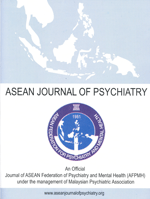


Google Scholar citation report
Citations : 5373
ASEAN Journal of Psychiatry received 5373 citations as per google scholar report
ASEAN Journal of Psychiatry peer review process verified at publons
| Journal Name | ASEAN Journal of Psychiatry (MyCite Report) | ||||
|---|---|---|---|---|---|
| Total Publications | 456 | ||||
| Total Citations | 5688 | ||||
| Total Non-self Citations | 12 | ||||
| Yearly Impact Factor | 0.93 | ||||
| 5-Year Impact Factor | 1.44 | ||||
| Immediacy Index | 0.1 | ||||
| Cited Half-life | 2.7 | ||||
| H-index | 30 | ||||
| Quartile |
|
- Anxiety Disorders
- Behavioural Science
- Biological Psychiatry
- Child and Adolescent Psychiatry
- Community Psychiatry
- Dementia
- Community Psychiatry
- Suicidal Behavior
- Social Psychiatry
- Psychiatry
- Psychiatry Diseases
- Psycho Trauma
- Posttraumatic Stress
- Psychiatric Symptoms
- Psychiatric Treatment
- Neurocognative Disorders (NCDs)
- Depression
- Mental Illness
- Neurological disorder
- Neurology
- Alzheimer's disease
- Parkinson's disease
Abstract
THE NURSE PERSONA: A 16PF PROFILING APPROACH FOR MENTAL HEALTH PROGRAM DEVELOPMENT
Author(s): July Anne Gahisan*, Michelle Cuevas, Hannah Dapin and Evangeline AguilanNursing is a challenging and pivotal profession in healthcare. As a result, nurses’ mental health is essential not only for their welfare but also for the quality of care they provide and the overall efficiency of the healthcare system. To address this issue, a personality profiling of employed nurses was conducted using the 16-personality factor questionnaire. The respondents were 32% male and 65% female nurses in a public hospital, selected through a structured random sampling technique. The statistical tools employed for analysis are percentage computation, mean distribution, Pearson correlation coefficient, and T-test. The dominant primary personality traits of the respondents were rule consciousness, emotional stability, perfectionism, privateness, vigilance, and warmth. On the other hand, they scored a low average for tension and average but not dominant personalities for liveliness, self-reliance, dominance, sensitivity, abstractedness, and social boldness. These dominant personality factors reflect the positive personality of the nurses; however, some factors like vigilance and privateness contribute to burnout, stress, and anxiety, along with other work-related factors. At the same time, there is a need to improve on other non-dominant personalities. Moreover, there was a significant relationship between personality and gender, indicating a strong to near-perfect correlation. However, there was no significant difference between the genders of male and female nurses and their personality profiles. Hence, nurses’ personality profiles are remarkably similar, irrespective of their gender. Therefore, the well-being and mental health programs employed to nurses and other health practitioners may be similar, irrespective of gender. At the same time, personality profiling using the 16PF may serve as a valuable tool for profiling employed nurses and maximizing their contribution to the well-being and mental health of professionals, ultimately contributing to the delivery of quality patient services.


























